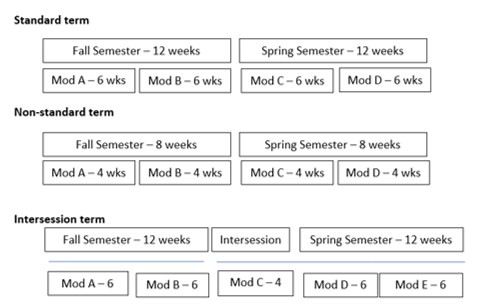Schools are educating a variety of students these days. With the rise in non-traditional students – or students who go to school at different stages of their lives – and with various lifestyles to accommodate, colleges and universities are changing traditional school models to create more options and flexibility for all students.
No longer are students forced to follow a traditional 12-week fall and spring semester schedule that could take four years to complete. Students can take classes shorter than 12 weeks, or classes that do not span the whole length of the semester, such as three-week, six-week and eight-week classes. With shorter classes, student can take more than one class in a standard semester. And by classes starting more frequently within a semester, schools can offer ongoing enrollment dates, allowing students to start taking classes at any point during the year compared to a traditional fall or spring start. Many schools also offer intersessions or classes that take place in-between the fall, spring and summer semesters.
Whether a nonprofit or for-profit institution, if you’re making these types of changes to accommodate your students, that means you’re becoming a modular-based program. While these are great benefits to offer students, there are certain ways to calculate Title IV aid. The Department of Education requires schools to report when Title IV eligible students begin, withdraw or cease attending a class under the Return of Title IV Funds (R2T4) calculation. R2T4 is used to calculate the earned and unearned portions of Title IV student aid. We’re finding that modular-based programs make it harder for financial aid professionals to provide accurate calculations because of the various options. Yet, miscalculations and inefficient processes not only put students at risk of not receiving their Title IV funding, but schools could lose Title IV funding as well. This is why it’s important to determine if your institution is operating a modular-based program.
Where does your university fit?
While there are three types of academic calendars – standard term (semesters, trimesters, quarters), non-standard term and non-term (clock-hour and credit-hour programs), most schools have trouble identifying where they fit in order to efficiently calculate Title IV funding. Under outdated regulations, Pell grants were based on whether a student physically filled a seat in the class room, which was easy to calculate. If they did not attend class, schools knew to recalculate Title IV funding by a certain date.
Now in today’s digital world where classes live online and the actual length and start date of classes varies, schools aren’t accurately calculating or disbursing Title IV funds as they should under new regulations and audit guidelines. For example, if a student decides to take three classes – one 5-week class at a time within a 15-week semester – and that student completes the first class, withdraws from the second class in week 6, but enrolls in the third class in week 11, schools often disburse the wrong amount of Title IV funds at the wrong time. This same concept applies if a student enrolls in an intersession class, say a three-week study abroad program within the summer term and drops before the start of the fall semester. Here are some visual examples of how classes can be formatted.

While this is a complex calculation with many variables, there are consequences of miscalculation. Through our experience, schools that don’t identify their modular-based programs are submitting financial statements with errors, leading the Department of Education to flag findings. Fixing these errors often becomes time-consuming and costly, especially if you’re not working with a financial aid auditing consultant.
If you’re still unsure where your school might fit, we’ve come up with some questions to help you determine if your school is offering a modular-based program. We recommend pulling together your financial aid team and the academic department to answer these questions together.
Is my school a modular-based program? Here are five key questions to answer:
- 1.) Do you offer intersession courses, mini sessions or j-terms sessions that take place in between semesters (i.e. spring break, holidays or summer)?
- Do you offer pre-start or fast-start sessions? Do you offer multiple summer sessions?
- Do you offer classes that have various time lengths (i.e. a student has the option to take a three-week, four-week, or eight-week class vs. all classes being 12-weeks long)?
- Do you offer classes that start at different times within a single semester?
- Are you having trouble calculating R2T4 when a student withdraws or drops a class?
If you’ve answered yes to one or more of these questions, you offer a modular-based program. One of the most common questions we receive is, “where do I start?” If you’re looking to determine if your school may be miscalculating R2T4, McClintock & Associates is ready to help.
As nationally recognized leaders in postsecondary education with over 40 years of experience in the industry, we have helped more than 100 schools – both nonprofit and for-profit – implement efficient and effective processes so schools can continue to provide the most beneficial options for their students.
McClintock director, Greg Rinderle, is often invited to speak about R2T4 calculations at regional and national conferences. Schools are welcome to contact Greg directly by phone at 412-319-6144 or by email at grinderle@mcclintockcpa.com.

